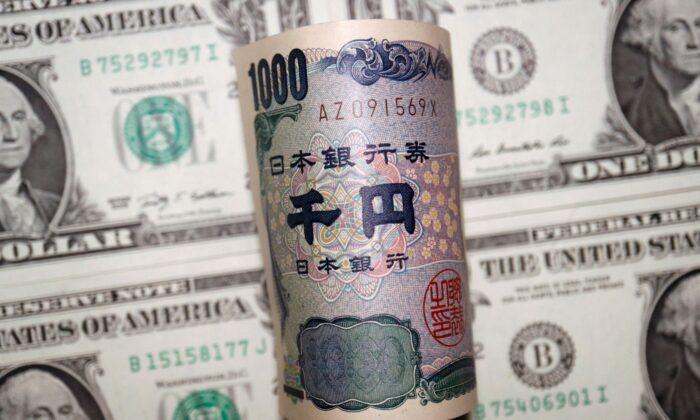LONDON/TOKYO—The Japanese yen fell as much as 1.9 percent on Friday after the Bank of Japan bucked a wave of tightening and stuck with its ultra-low interest rate stance, as currency markets looked set for another volatile session after a spate of rate hikes this week.
The Swiss National Bank’s surprise decision to raise rates by 0.5 percent continued to reverberate through markets, with the euro losing half a percent and the franc heading back towards two-month highs hit immediately after Thursday’s announcement.
Currency markets, facing the biggest run of monetary policy tightening for decades, are also having to contend with a massive drop in risk sentiment that has sent equity markets tumbling.
The Australian dollar, very sensitive to the broad global investment mood, dropped 0.9 percent to $0.6981 as stock markets in Asia tumbled following big falls on Wall Street on Thursday.
The U.S. dollar clawed its way back from a one-week low against major peers, following a two-day slide after the Federal Reserve’s mid-week rate increase that, although the biggest since 1995, didn’t exceed market expectations.
Against the yen, the greenback climbed 1.6 percent to 134.14 yen following a lot of volatility in the immediate aftermath of the BOJ’s decision. Initially it extended gains to as much as 1.89 percent to reach 134.64.
The yen on Wednesday had reached a 24-year low of 135.6 per dollar.
“The BoJ disappointed today by keeping all policy settings unchanged,” said Citi’s Naveen Nair. He noted that with Japanese government bond yields trading above the BOJ’s cap of 0.25 percent, markets were “seemingly still holding some hope for a BoJ capitulation.”
The euro lost 0.5 percent to $1.0499, although it was above levels reached on Thursday.
The euro was down 0.3 percent to the Swiss franc at 1.0165 francs per euro. The franc had rocketed to a two-month high on Thursday after the rate hike and a sense among investors that the SNB would not try and stop a strengthening franc as it has the past.
The dollar bounced 0.2 percent to 0.9684 francs, after tumbling the most in seven years overnight.
The dollar index, which measures the currency against a basket of six rivals, rose 0.6 percent to 104.48.
U.S. long-term yields, which bear a close correlation with the dollar-yen rate, were stable in Tokyo on Friday, after dipping sharply during U.S. hours as investors worried that aggressive Fed tightening could trigger a recession.
“The slippage in U.S. yields and recession talk has undercut the DXY (U.S. dollar index) last couple days,” Westpac analysts wrote in a client note, referring to the dollar index. “DXY slippage can extend to 102 near term, but the broader bull trend is not done, not with another 75bp Fed hike on the table in July.”
Sterling slipped 0.7 percent to $1.2267, giving back some of its 1.43 percent jump overnight, when the Bank of England decided to lift rates again—albeit by less than many in the market had expected—along with a hawkish signal about future policy action.





